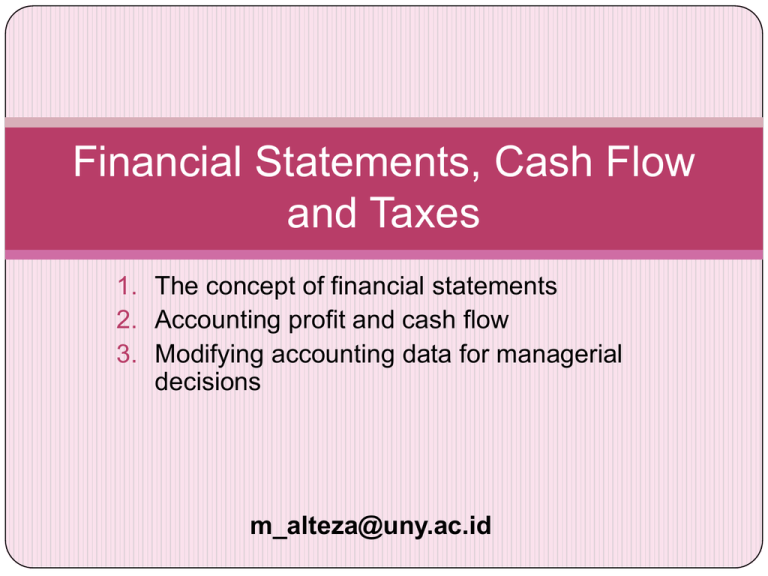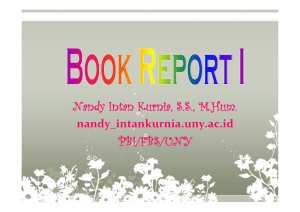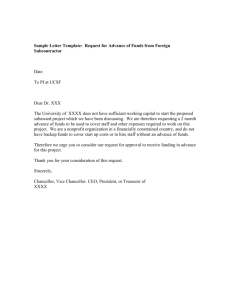Materi Financial Management_Financial Statements
advertisement

Financial Statements, Cash Flow and Taxes 1. The concept of financial statements 2. Accounting profit and cash flow 3. Modifying accounting data for managerial decisions m_alteza@uny.ac.id Financial Statements Annual report: A report issued annually by a corporation to its stockholders. Two types of information given in this report: 1) The verbal section, often presented as a letter from the director, that describes the firm’s operating results during the past year and discusses new developments that will affect the future operations. 2) Four basic financial statements-the balance sheet, the income statement, the statement of retained earnings and the statement of cash flows. Financial statements are utilized by investor, creditor, supplier, banks etc. m_alteza@uny.ac.id The Balance Sheet A statement of the firm’s financial position at a specific point in time The left-hand side shows the firm’s assets, while the right-hand side shows the liabilities and equity, or the claims against the assets. These assets are listed in order of their liquidity or the length of time it typically takes to convert them to cash. The claims are listed in the order in which they must be paid. m_alteza@uny.ac.id Balance Sheet PT Mandiri Sejahtera December 31, 20xx ASSETS Current Assets • Cash and marketable securities • Accounts receivable • Inventories Total Current Assets Fixed Assets •Net plant and equipment •Net machine Total net fixed assets LIABILITIES AND EQUITY Current Liabilities • Accounts payable • Notes payable • Accruals Total Current Liabilities Long-term bonds Total Liabilities • Preferred stock •Common stock •Retained earnings Total Common Equity TOTAL ASSETS TOTAL LIABILITIES AND EQUITY m_alteza@uny.ac.id The Income Statement A statement summarizing the firm’s revenues and expenses over an accounting period, generally a quarter or a year. A report of earnings and dividend per share is given at the bottom of the income statement. Earnings per share (EPS) is called the bottom line, denoting that of all the items on the income statement, EPS is the most important. m_alteza@uny.ac.id INCOME STATEMENT Sales xxx Cost of Goods Sold xxx - Gross Profit xxx Operating costs xxx- EBITDA xxx Depreciation & Amotization EBIT (Operating income) Interest EBT Taxes Net income before preferred dividends Preferred dividends Net income (EAT) Per share data Common Stock price Earnings Per Share (EPS) Dividends Per Share (DPS) xxxxxx xxx- m_alteza@uny.ac.id xxx xxxxxx xxxxxx xxx xxx xxx Statement of Retained Earnings A statement reporting how much of the firm’s earnings were retained in the business rather than paid out in dividends. Retained earnings represent a claim against assets, not assets per se. Retained earnings do not represent cash and are not “available” for the payment of dividends or anything else. m_alteza@uny.ac.id Statements of Retained Earnings PT Mandiri Sejahtera December 31, 20xx Balance of retained earnings, December 31,20xx (Add) Net income 20xx (Less) Dividends to common stockholders Balance of retained earnings, December 31,20xx m_alteza@uny.ac.id xxx xxx xxx xxx Statement of Cash Flows The company’s cash position as reported on the balance sheet is affected by a greatmany factors, including the following: 1. Cash Flow 2. Changes in working capital 3. Fixed assets 4. Security transactions and dividends payments. Each of above factors is reflected in the statement of cash flows, which summarizes the changes in a company’s cash position. m_alteza@uny.ac.id Statement of Cash Flows The statement separates activities into three categories: 1. Operating activities, which includes net income, depreciation, and changes in current assets and current liabilities other than cash and short-term debt. 2. Investing activities, which includes investments in or sales of fixed assets. 3. Financing activities, which includes cash raised during the year by issuing short-term debt, long-term debt, or stock. Also, since dividends paid or cash used to buy back outstanding stock or bonds reduces the company’s cash, such transactions are included here. m_alteza@uny.ac.id Statements of Cash Flows Operating activities Net income before preferred dividends XXXX Additions (sources of cash) Depreciation and amortization XXXX Increase in accounts payable XXXX Increase in accruals XXXX Substractions (uses of cash) Increase in accounts receivable (XXXX) Increase in inventories (XXXX) Net cash provided by operating activities XXXX Long-term investing activities Cash used to acquire fixed assets (XXXX) Financing activities Increase in notes payable XXXX Increase in bonds XXXX Payment of common and preferred dividends XXXX Net cash provided by financing activities XXXX Net increase (decrease) in cash XXXX Cash and securities at beginning of year XXXX Cash and securities at end of year XXXX m_alteza@uny.ac.id Accounting Profit vs Net Cash Flow When we studied income statements in accounting, our emphasis was probably on the firm’s net income. In finance, however, we focus on net cash flow. The value of an asset (or a whole firm) Is determined by the cash flow it generates. Net cash flow is the actual net cash, as opposed to accounting net income, that a firm generates during some specified period. A business’s net cash flow generally differs from its accounting profit because some of the revenues and expenses listed on the income statement were not paid in cash during the year. m_alteza@uny.ac.id Accounting Profit vs Net Cash Flow The relationship between net cash flow and net income can be expressed as follows: Net cash flow = Net income-Noncash revenues + Noncash charges Typically, depreciation and amortization are the largest noncash items and in many cases the other noncash items roughly net out to zero. For this reason, those relationship can be expressed like this: Net cash flow = Net income* + Depreciation & amortization m_alteza@uny.ac.id Modifying Accounting Data for Managerial Decision 1. Divide total assets into two categories: Operating assets consist of the cash and marketable securities, accounts receivables, investories and fixed assets necessary to operate the business. Operating assets are further divided into working capital and fixed assets such as plant and equipment. Non operating assets which would include cash and marketable securities above the level required for normal operations, investment in subsidiaries, land held for future use and the like. m_alteza@uny.ac.id Modifying Accounting Data for Managerial Decision Operating working capital is current assets used in operations. Net operating working capital is the working capital acquired with investor-supplied funds. Net operating working capital = all current assets- all current liabilities that do not charge interest. Net operating working capital = (Cash and marketable securities + accounts receivables + inventory) – (accounts payable+accruals). m_alteza@uny.ac.id Modifying Accounting Data for Managerial Decision 2. Calculating Net Operating Profit After Tax (NOPAT) If two companies have different amount of debt, hence different interest charges, they could have identical operating performances but different net income- the one with more debt would have a lower net income. A better measurement for comparing managers’ performance is net operating profit after taxes (NOPAT) NOPAT is the amount of profit a company would generate if it had no debt and held no nonoperating assets. NOPAT = EBIT (1-Tax rate) m_alteza@uny.ac.id Modifying Accounting Data for Managerial Decision 3. Calculating Free Cash Flow (FCF) Free cash flow is the cash flow actually available for distribution to all investors after the company has made all the investments in fixed assets, new products and working capital necessary to sustain ongoing operations. FCF = Operating cash flow- Gross investment in operating capital. Operating cash flow = NOPAT+ Depreciation & amortization. Gross investment in operating capital = Net investment + Depreciation & amortization. m_alteza@uny.ac.id Modifying Accounting Data for Managerial Decision If we substract depreciation and amortization from both operating cash flow and gross investment in operating capital we obtain the following equivalent expression for free cash flow: FCF = NOPAT – Net investment in operating capital m_alteza@uny.ac.id Market Value Added (MVA) MVA measures the managerial effectiveness since the very inception of a company. MVA is the difference between the market value of the firm’s stock and amount of equity capital investors have supplied. Those can be formulated as follows: MVA = (Shares outstanding)(Stock price)- Total common equity m_alteza@uny.ac.id Economic Value Added (EVA) EVA focuses on managerial effectiveness in a given year. In order to generate positive EVA, a firm has to more than just cover operating costs. It must also provide a return to those who have provided the firm with capital. EVA takes into account the total cost of capital, which includes the cost of equity EVA EVA = NOPAT- after tax dollar cost of operating capital = EBIT (1-tax rate)- (total investor-supplied operating capital) x (after-tax percentage cost of capital) m_alteza@uny.ac.id

